The NVIDIA GeForce GTX 980 Ti Review
by Ryan Smith on May 31, 2015 6:00 PM ESTPower, Temperature, & Noise
As always, last but not least is our look at power, temperature, and noise. Next to price and performance of course, these are some of the most important aspects of a GPU, due in large part to the impact of noise. All things considered, a loud card is undesirable unless there’s a sufficiently good reason – or sufficiently good performance – to ignore the noise.
As the GM200 flagship card, GTX Titan X gets the pick of the litter as far as GM200 GPUs go. GTX Titan X needed fully-functional GM200 GPUs, and even then needed GPUs that were good enough to meet NVIDIA’s power requirements. GTX 980 Ti on the other hand, as a cut-down/salvage card, gets second pick. So we expect to see these chips be just a bit worse; to have either functional units that came out of the fab damaged, or have functional units that have been turned off due to power reasons.
| GeForce GTX Titan X/980 Voltages | ||||
| GTX Titan X Boost Voltage | GTX 980 Ti Boost Voltage | GTX 980 Boost Voltage | ||
| 1.162v | 1.187v | 1.225v | ||
Looking at voltages, we can see just that in our samples. GTX 980 Ti has a slightly higher boost voltage – 1.187v – than our GTX Titan X. NVIDIA sometimes bins their second-tier cards for lower voltage, but this isn’t something we’re seeing here. Nor is there necessarily a need to bin in such a manner since the 250W TDP is unchanged from GTX Titan X.
| GeForce GTX 980 Ti Average Clockspeeds | |||
| Game | GTX 980 Ti | GTX Titan X | |
| Max Boost Clock | 1202MHz | 1215MHz | |
| Battlefield 4 |
1139MHz
|
1088MHz
|
|
| Crysis 3 |
1177MHz
|
1113MHz
|
|
| Mordor |
1151MHz
|
1126MHz
|
|
| Civilization: BE |
1101MHz
|
1088MHz
|
|
| Dragon Age |
1189MHz
|
1189MHz
|
|
| Talos Principle |
1177MHz
|
1126MHz
|
|
| Far Cry 4 |
1139MHz
|
1101MHz
|
|
| Total War: Attila |
1139MHz
|
1088MHz
|
|
| GRID Autosport |
1164MHz
|
1151MHz
|
|
| Grand Theft Auto V |
1189MHz
|
1189MHz
|
|
The far more interesting story here is GTX 980 Ti’s clockspeeds. As we have pointed out time and time again, GTX 980 Ti’s gaming performance trails GTX Titan X by just a few percent, this despite the fact that GTX 980 Ti is down by 2 SMMs and is clocked identically. On paper there is a 9% performance difference that in the real world we’re not seeing. So what’s going on?
The answer to that is that what GTX 980 Ti lacks in SMMs it’s making up in clockspeeds. The card’s average clockspeeds are frequently two or more bins ahead of GTX Titan X, topping out at a 64MHz advantage under Crysis 3. All of this comes despite the fact that GTX 980 Ti has a lower maximum boost clock than GTX Titan X, topping out one bin lower at 1202MHz to GTX Titan X’s 1215MHz.
Ultimately the higher clockspeeds are a result of the increased power and thermal headroom the GTX 980 Ti picks up from halving the number of VRAM chips along with disabling two SMMs. With those components no longer consuming power or generating heat, and yet the TDP staying at 250W, GTX 980 Ti can spend its power savings to boost just a bit higher. This in turn compresses the performance gap between the two cards (despite what the specs say), which coupled with the fact that performance doesn't scale lineraly with SMM count or clockspeed (you rarely lose the full theoretical performance amount when shedding frequency or functional units) leads to the GTX 980 Ti trailing the GTX Titan X by an average of just 3%.
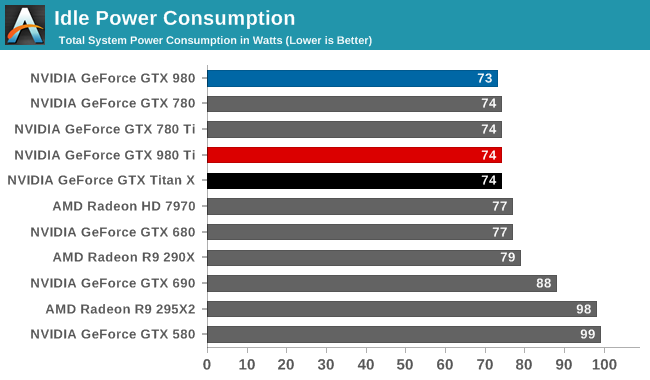
Starting off with idle power consumption, there's nothing new to report here. GTX 980 Ti performs just like the GTX Titan X, which at 74W is second only to the GTX 980 by a single watt.
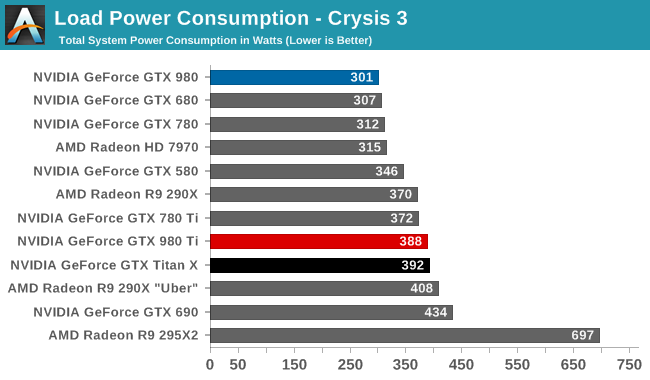
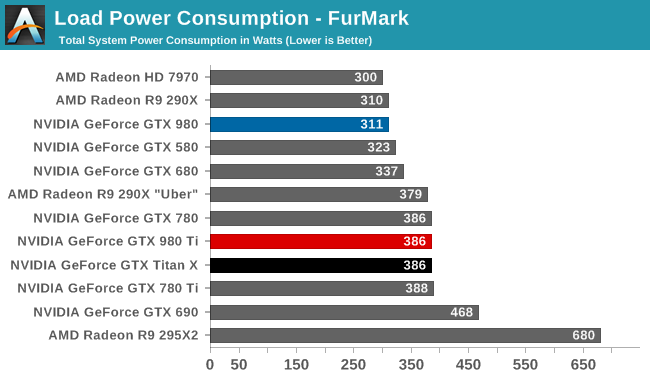
Meanwhile load power consumption is also practically identical to the GTX Titan X. With the same GPU on the same board operating at the same TDP, GTX 980 Ti ends up right where we expect it, next to GTX Titan X. GTX Titan X did very well as far as energy efficiency is concerned – setting a new bar for 250W cards – and GTX 980 Ti in turn does just as well.
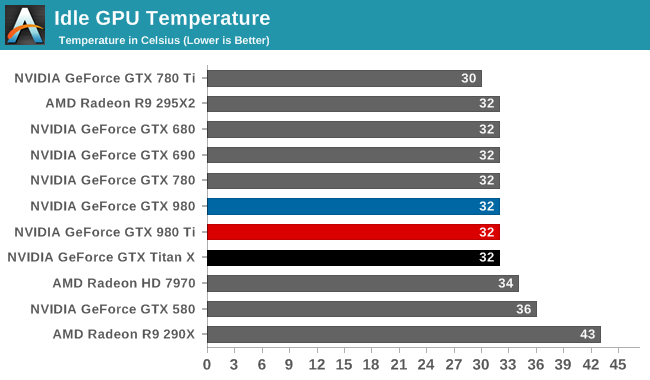
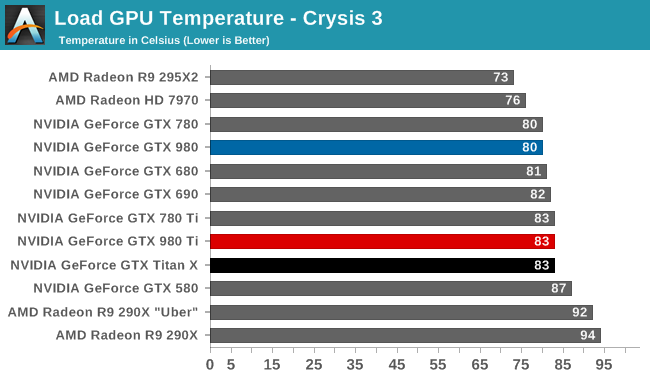
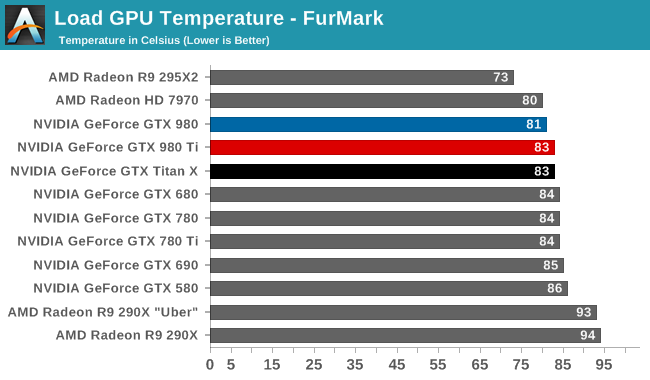
As was the case with power consumption, video card temperatures are similarly unchanged. NVIDIA’s metal cooler does a great job here, keeping temperatures low at idle while NVIDIA’s GPU Boost mechanism keeps temperatures from exceeding 83C under full load.
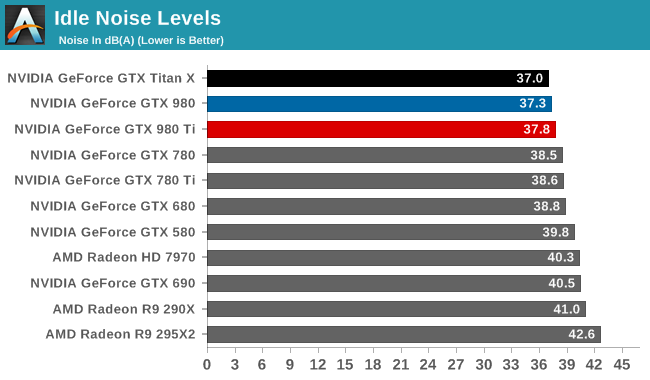
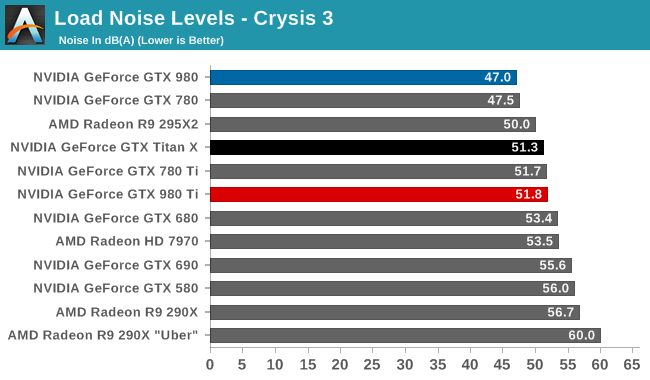
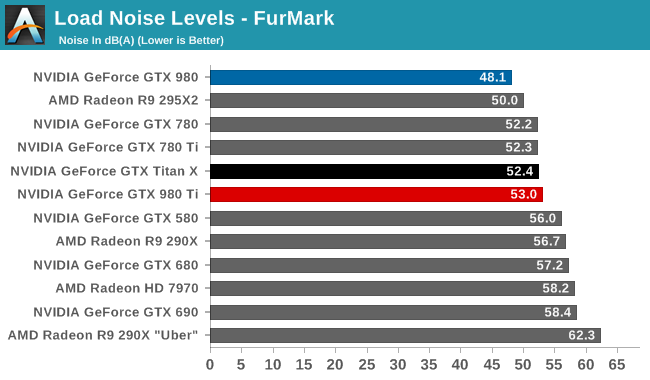
Finally for noise, the situation is much the same. Unexpected but not all that surprising, the GTX 980 Ti ends up doing a hair worse than the GTX Titan X here. NVIDIA has not changed the fan curves or TDP, so this ultimately comes down to manufacturing variability in NVIDIA’s metal cooler, with our GTX 980 Ti faring ever so slightly worse than the Titan. Which is to say that it's still right at the sweet spot for noise versus power consumption, dissipating 250W at no more than 53dB, and once again proving the mettle of NVIDIA's metal cooler.










290 Comments
View All Comments
douglord - Monday, June 1, 2015 - link
I need to know if the 980ti can output 10-bit color correctly? Is it ready for UHD Blueray?dragonsqrrl - Monday, June 1, 2015 - link
To my knowledge only Quadro's and Firepro's output 10 bit color depth.johnpombrio - Monday, June 1, 2015 - link
Any card that can do true RGB color schemes are NOT MEANT for normal users. It brings a lot of drawbacks for games and normal tasks. These type of cards are for graphics professionals only. Google it to see why.mapesdhs - Wednesday, June 3, 2015 - link
Indeed, the way colourspaces interact with different types of monitor can result in some nasty issues for accurate colour presentation. For home users, it's really not suitable since so many normal apps & games aren't written to utilise such modes correctly. Besides, I doubt any 4K TVs could properly resolve 10bis/channel anyway. Funny though that people are still asking about 10bit colour when pro users were already using 12bit more than 20 years ago. :D Also 16bit greyscale for medical/GIS/etc.johnpombrio - Monday, June 1, 2015 - link
Yikes! That overclock ability! I always buy EVGA's superclocked NVidia cards as they as super stable and have great benchmarks (as well as playing games well, heh). I might buy into this even tho I have a GTX980.As for AMD, NVidia has 76% of the discrete GPU graphics card market (and still rising) while AMD has lost 12% market share in the last 12 months alone. Whatever AMD has up for new products, it better hurry and be a LOT better than NVidia cards. AMD has tried the " rebadge existing GPU family cards, reduce its price, and bundle games" for too long and IT IS NOT WORKING. C'mon AMD, get back into the fight.
mapesdhs - Wednesday, June 3, 2015 - link
True, I kept finding EVGA's cards work really well. The ACX2 980 (1266MHz) is particularly good.Nfarce - Monday, June 1, 2015 - link
Well I recently upgraded with a second 970 for SLI for 1440p gaming and have them overclocked to 980 performance. It's roughly 15% faster than this single card solution for $700 vs. $650 (7.5% increase in cost). But one thing is for certain: we are still a long time away from realistic 4K gaming with a G-sync 120Hz monitor when those come out. I would much prefer 1440p gaming with max quality and high AA settings and faster FPS matched to screen Hz than detuned 4K settings (even if AA is less meaningful at 2160p).By the way: are you guys ever going to add Project Cars to your benchmarks? It has rapidly become THE racer to own. Grid Autosport is not really a good benchmark these days because it's just a rehash of the Grid 2 engine (EGO 3.0)...easy on GPUs. Many, including me, haven't touched Autosport since PCars was released and may never touch it again.
mapesdhs - Wednesday, June 3, 2015 - link
Project Cards is one game that runs badly in CF atm (driver issues), which would make the 295x2 look horrible. Might be better to wait until AMD has fixed the issue first.agentbb007 - Monday, June 1, 2015 - link
A GTX Titan X for $649, DOH BART! Oh well I've enjoyed my SLI Titan X's for a few months so I guess that was worth the $700 premium. I keep falling for nVidia's Titan brand gimmick, I also bought the original Titan luckily just 1 of them and ended up selling it for about half what I paid.Lesson learned, AGAIN, don't buy the Titan brand wait for the regular GTX version instead.
mapesdhs - Tuesday, March 12, 2019 - link
2019 calling! I wonder if he bought the 2080 Ti or RTX Titan... :}